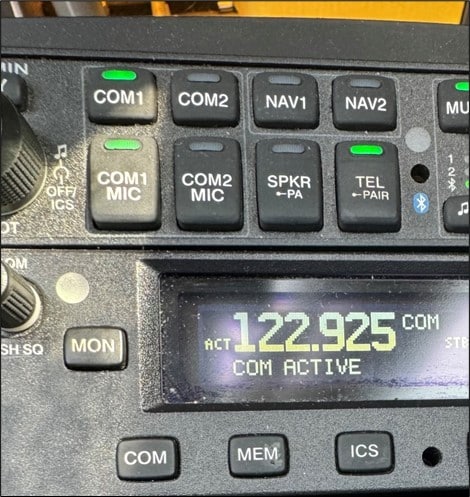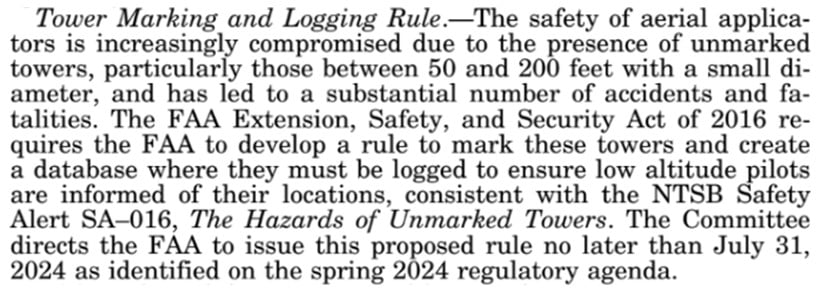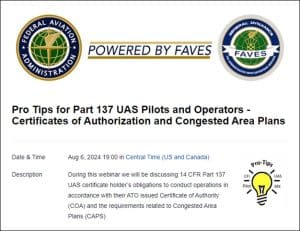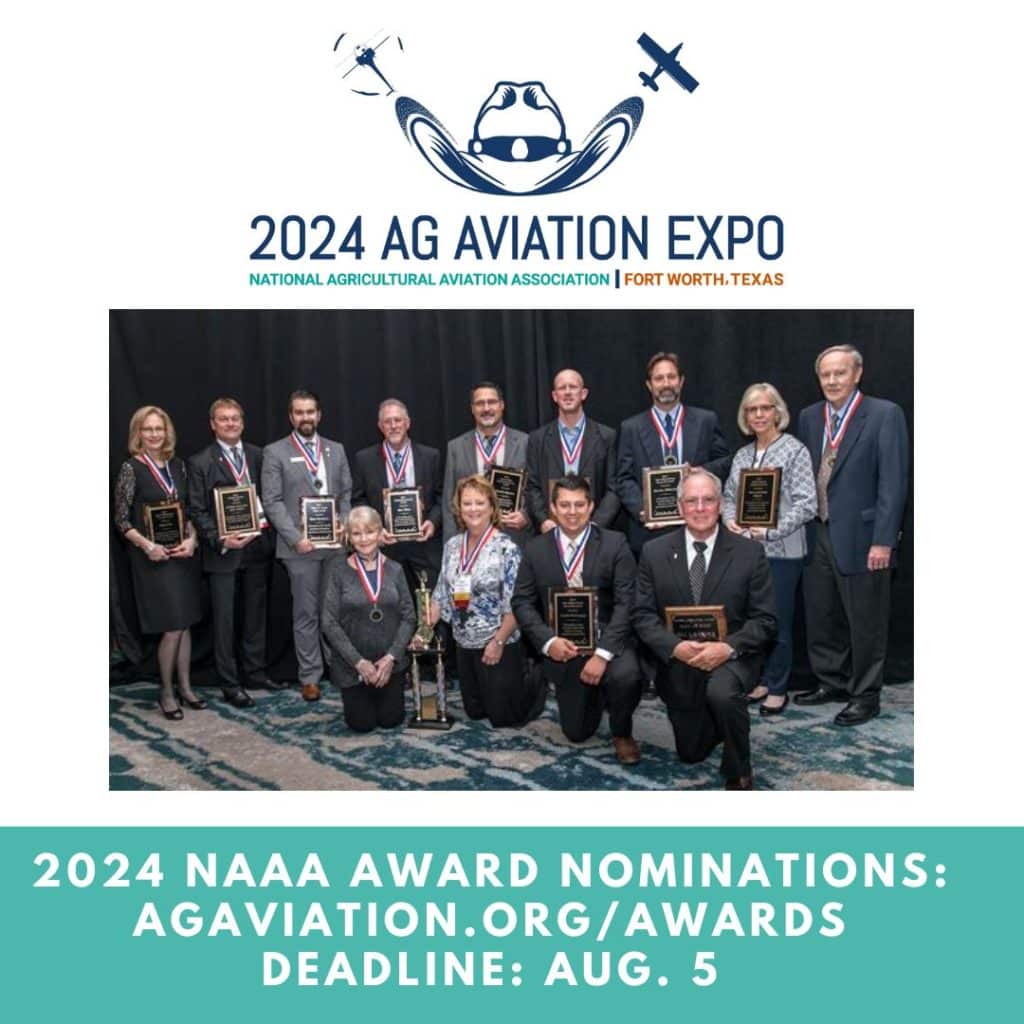Click on the article title below to be taken directly to the article. After you’re done reading the article, click “Back to Top” at the bottom to be brought back to the Table of Contents.
Table of Contents
- FAA Approves Frequency 122.925 for Air-to-Air Communications Between Agricultural Aircraft Beginning Immediately
- Senate Appropriations FAA Funding Bill with NAAA Advocated Language Urging Tower Marking and Logging
- NAAA Submits Comments to EPA Opposing Bans for Two Pesticides—Acephate and Thiram
- Ray Cottingham Fatally Injured in Ag Accident in Indiana
- Uncrewed Aircraft Operators, Register for the “Pro Tips for Part 137 UAS Pilots and Operators” Webinar, August 6 at 8:00 PM EST
- NAAA Award Nominations due by Monday, August 5
- FAA Revises R22/R44 Special Training and Experience Requirements
- In Case You Missed Last Week’s NAAA eNewsletter
FAA Approves Frequency 122.925 for Air-to-Air Communications Between Agricultural Aircraft Beginning Immediately

NAAA has worked to secure permission from the FAA to use frequency 122.925 for radio communications between agricultural aircraft. This frequency is currently assigned to forestry management and fire suppression, fish and game management and protection, and environmental monitoring and protection. FAA’s decision means ag aviators can now use it as well now. FAA indicated the use of 122.925 “may be encouraged to enhance the situational awareness and safety of the participating [ag aviation] operators and others who choose to monitor/use the frequency.”
NAAA has been working on this issue with the FAA well before the season began in earnest. The frequency 122.925 was selected by both NAAA and FAA representatives as the best option for designating a radio frequency that could be used nationwide for ag aircraft communications. FAA personnel worked with their Air Traffic Organization to investigate if this would be possible, and recently received word that ag aviation’s use of this frequency was acceptable.
When using 122.925 to communicate with other agricultural aircraft in your working area, please be respectful in how you use it. Report safety related information only, such as location, etc. – do not transmit any unnecessary information. Remember that this frequency is also used for firefighting, so proper radio etiquette must be maintained.
All ag aviators are strongly encouraged to begin using 122.925 for communicating with each other immediately. With three mid-air collisions so far in 2024, it is imperative that we do everything possible to make sure all ag aircraft know the location of other ag aircraft working in the area. Radio communications, ADS-B, and situation awareness are all important to ensure there are no mid-air collisions in 2024 and beyond.
NAAA will also begin the process to petition the FCC to officially list “agricultural aircraft operations” as an additional designated use for 122.925 in table 4-1-2 in FAA’s Aeronautical Information Manual. NAAA has been advised this process will be lengthy and complicated. NAAA’s undertaking of this effort does not change the fact that 122.925 is now available per FAA’s facilitation for ag aviation communications.
Back to top
Senate Appropriations FAA Funding Bill with NAAA Advocated Language Urging Tower Marking and Logging
The U.S. Senate Appropriations Committee approved the fiscal 2025 Transportation, Housing and Urban Development spending bill last week providing $110 billion in total funding for the Transportation Department. That sum includes $22 billion for the FAA. In addition, the report accompanying the bill includes NAAA advocated language urging the FAA to promulgate statutory language enacted as part of the FAA Reauthorization Bill Extension in 2016 to establish a database and marking of towers between 50 and 200 feet in rural areas. The appropriations committee report language states:

Tower Marking and Logging Rule.—The safety of aerial applicators is increasingly compromised due to the presence of unmarked towers, particularly those between 50 and 200 feet with a small diameter, and has led to a substantial number of accidents and fatalities. The FAA Extension, Safety, and Security Act of 2016 requires the FAA to develop a rule to mark these towers and create a database where they must be logged to ensure low altitude pilots are informed of their locations, consistent with the NTSB Safety Alert SA-016, The Hazards of Unmarked Towers. The Committee directs the FAA to issue this proposed rule no later than July 31, 2024 as identified on the spring 2024 regulatory agenda.
NAAA Submits Comments to EPA Opposing Bans for Two Pesticides—Acephate and Thiram
On Monday NAAA submitted comments to EPA on two pesticides – acephate and thiram. EPA previously published a proposed interim decision (PID) for acephate that banned all uses except for tree injections. For thriam, EPA published an amended PID that banned all conventional and seed treatment uses except for farm seed treatments with liquid formulations. For both pesticides, the risks of concern driving the proposed bans were related to human health, including exposure from spray drift to bystanders and inhalation or dermal exposure to mixers and loaders.
While none of the risks of concern or the bans were specifically related to aerial application, NAAA still commented against both PIDs. Acephate is an important insecticide on cotton and soybeans in the southern part of the U.S. and is frequently applied by aerial application. While thiram is not commonly used on many crops or commonly applied by air, NAAA nevertheless commented against the ban, as the reasons EPA proposed banning it were similar to those for acephate. NAAA’s comments on both PIDs focused on the use of the inaccurate Tier 1 AgDRIFT model and mitigation options for mixers and loader. You can read NAAA’s full comments on acephate and thiram.
Back to top
Ray Cottingham Fatally Injured in Ag Accident in Indiana
NAAA wishes to extend condolences to the family and friends of Robert Ray Cottingham who lost his life in an ag aviation accident on July 22, 2024. Ray, as he preferred to be called, was born on October 29, 1988, and was 35 years old at the time of his passing.

Ray’s calling in life had been agricultural since the age of eight. An interest in farming grew to include an interest in aviation after attending AirVenture in Oshkosh Wisconsin with his father. Ray received a bachelor’s degree in agricultural business management from Purdue University where he also began flying. He then moved into ag aviation, which perfectly matched his two interests, first in piston aircraft and later transitioning into turbine powered airplanes.
Ray’s visitation was held on July 26 in Williamsport Indiana; his funeral was held the following day. Ray leaves behind a wife and her two children, his parents, sister, and several aunts, uncles, and cousins. Donations in Ray’s memory to support his wife’s children’s education can be made out to the Shirley Education Fund and sent to 5190 E 550 N, Attica, IN 47918. To read Ray’s full obituary, click here.
Back to top
Uncrewed Aircraft Operators, Register for the “Pro Tips for Part 137 UAS Pilots and Operators” Webinar, August 6 at 8:00 PM EST

It is imperative for uncrewed aircraft operators to ensure the safety of the low-altitude airspace for the well-being of other, manned aircraft and for the reputation and professionalism of commercial drone operations. Proper certification, abidance of safety and environmental regulations, and continuing education facilitate safety and professionalism in the uncrewed space. As such, please register for the FAA FAST webinar on August 6 at 8:00 PM EST titled “Pro Tips for Part 137 Pilots and Operators – Certificates of Authorization and Congested Area Plans.” The webinar will discuss 14 CFR Part 137 UAS certificate holder’s obligations to conduct operations in accordance with their ATO-issued Certificate of Authority (COA) and the requirements related to Congested Area Plans (CAPS). To register for this webinar, click here.
Back to top
NAAA Award Nominations due by Monday, August 5

Do you have a rising pilot within your ranks? Do you admire certain NAAA members’ outstanding service to the industry or their community? The NAAA awards nomination deadline is August 5. The aerial application industry is filled with exceptional people who go above and beyond the call of duty, often with little fanfare. Make someone’s day or year by nominating them for a 2024 NAAA Award.
NAAA’s online submission form is easy and quick to use; nominate someone in just a few clicks here.
Who will be among this year’s awardees? There are nine NAAA Award categories and one NAAREF Award. Nominations are due Aug. 5.
NAAA Award Categories
Agrinaut Award: Honors an agricultural aircraft operator, operating organization, or allied member company that has made an outstanding contribution in the field of ag aircraft operations. The achievement cited shall have contributed to the “state-of-the-art” for the benefit of the agricultural aircraft industry as a whole.
Allied Industry Individual Award: Recognizes an NAAA member or staff and/or an allied industry individual who has significantly contributed their efforts for the benefit of the allied industry and the aerial application industry. (Presented by the NAAA Allied Industry Committee.)
Delta Air Lines “Puffer” Award: Recognizes an individual who has made an outstanding contribution to the design of agricultural aircraft and/or related equipment.
Evans-Christopher Operation S.A.F.E. Award: Recognizes individuals or entities that have made outstanding contributions to the Operation S.A.F.E. program. (Presented by NAAREF.)
John Robert Horne Memorial Award: Honors a pilot with five or fewer years of experience in the agricultural aviation industry who has an exemplary safety record and has contributed to safety in ag aviation. This award no longer has carryover nominations from year to year; a new nomination must be submitted every year.
Larsen-Miller Community Service Award: Recognizes outstanding contributions by a member to his or her community.
Opal and Bill Binnion Memorial Award: Acknowledges those who contribute to NAAA in its efforts to educate the public about aerial application.
Richard “Dick” Reade Memorial Award: Recognizes outstanding contributions by an allied industry member and their company.
William O. Marsh Safety Award: Recognizes significant achievements in safety, safety education or an outstanding operational safety program.
Zoren and Joan O’Brien Memorial Outstanding Service Award: Awards outstanding service to the commercial agricultural aviation industry or to its association.
The 2024 NAAA Award recipients will be honored at the Excellence in Ag Aviation Banquet on Nov. 20 in Fort Worth, Texas.
Back to top
FAA Revises R22/R44 Special Training and Experience Requirements
The FAA recently issued a final rule to revise the Special Federal Aviation Regulation No. 73 – Robinson R22/R44 Special Training and Experience Requirements (SFAR) to provide consistency with other FAA regulatory requirements, training, Airman Certification Standards (ACS) and Practical Test Standards (PTS).
Effective August 22, 2024, this final rule:
- Removes the low gravity flight instruction requirement to align the SFAR with current aircraft placard requirements and the limitations section of the Robinson Helicopter Company Rotorcraft Flight Manual/Pilot Operating Handbook (RFM/POH) set forth by Airworthiness Directives.
- Amends certain terminology in the SFAR to mirror the Helicopter Flying Handbook, ACS and PTS.
- Clarifies the awareness training endorsement and flight review requirements for less experienced pilots, removes legacy dates and updates the applicability section to include ground and flight training, including flight reviews provided by flight instructors.
- Adds an expiration date to the SFAR to allow the FAA time to review and refine the R22 and R44 requirements for ground training, aeronautical experience, including flight training and flight reviews, before permanently adopting them into an independent separate subchapter.
You can the final rule here.
Back to top
In Case You Missed Last Week’s NAAA eNewsletter
Click here for the July 25, 2024 eNewsletter to read:
- NAAA Comments on Part 137 UAS Petition to Remove Medical Certificate Requirements
- UAS “Advanced Operations” Exemptions: Update
- Air Tractor to Exhibit at 2024 Farm Progress Show
- Brazilian Ag Aviator Juliana Turchetti Fatally Injured in Firefighting Accident
- NAAA Ag Aviation Expo Attendee Registration Now Open
- NAAA Award Nominations due by August 5
- AD Issued for Bell 407 Fuel System Standpipe

